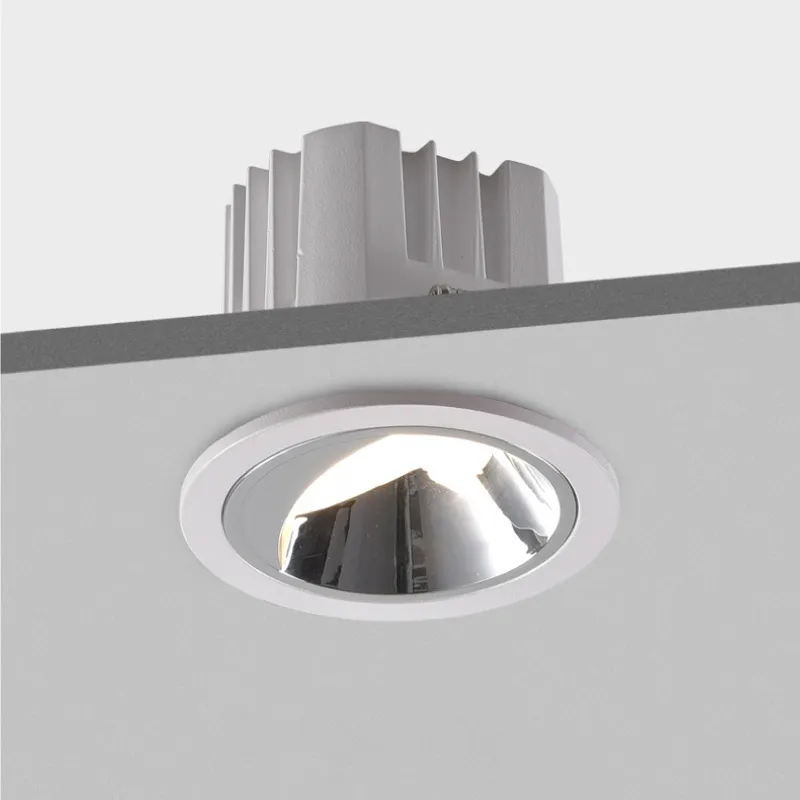In the field of downlight control modes, in addition to 0-10V, DALI, and TRIAC, On/Off (switch control) is the most basic control method, which only supports turning the lamp on and off without dimming function. The following is a comprehensive analysis of these four modes in terms of principles, characteristics, applicable scenarios, etc., to help you choose according to your needs.
I. Core Principles and Characteristics of the Four Control Modes
1. On/Off (Switch Control)
- Working Principle: Controls the on/off of the lamp through a simple switch (mechanical switch or smart switch), involving only the connection of live wire and neutral wire. The lamp lights up at full power when energized and turns off when de-energized.
- Characteristics:
- The simplest structure and the lowest cost (no additional control modules required, only a basic switch);
- No dimming function, with fixed brightness at 100%;
- Extremely strong compatibility, supporting all lamps (including LED, incandescent lamps, etc.);
- Single control logic, only capable of overall switching, without grouping or brightness adjustment.
2. TRIAC (Thyristor Dimming)
- Working Principle: Adjusts the voltage by changing the conduction angle of alternating current (cutting the sine wave) to control the brightness of the lamp. It is the mainstream dimming method for traditional incandescent lamps and halogen lamps, and is currently also applicable to compatible LED downlights.
- Characteristics:
- Low cost and strong compatibility (most LED downlights support it by default);
- Narrow dimming range (usually 10%-100%), with possible strobing or noise at low brightness;
- Only supports single-circuit synchronous dimming, without intelligent control or status feedback functions.
3. 0-10V Dimming
- Working Principle: Transmits control signals through an independent 0-10V low-voltage signal line (0V for turning off the lamp, 10V for maximum brightness, and brightness is adjusted synchronously when the voltage changes linearly between 0-10V). The lamp needs to be equipped with a dedicated 0-10V driver.
- Characteristics:
- Wide dimming range (1%-100%), no strobing, and good brightness linearity;
- Supports synchronous control of multiple lamps (multiple lamps can be connected to the same signal line);
- Requires additional wiring (live wire, neutral wire + 0-10V signal line), with higher cost than TRIAC;
- Can be connected to external sensors (such as light sensors, human body sensors) for simple automation, but with limited intelligence.
4. DALI (Digital Addressable Lighting Interface)
- Working Principle: Based on a bidirectional communication protocol of digital signals, sends instructions through two signal lines (DALI lines), enabling independent addressing and precise control (brightness, on/off, scenes, etc.) of a single lamp or a group of lamps. The lamp needs to be equipped with a DALI driver to support protocol parsing.
- Characteristics:
- Extremely high dimming precision (0.1%-100%), no strobing, and supports smooth dimming;
- Supports independent control of single lamps (addressing function), and flexible grouping and scene setting (such as office mode, energy-saving mode);
- Bidirectional communication, capable of feeding back lamp status (such as faults, power), facilitating system monitoring and maintenance;
- Simple wiring (two signal lines in parallel for all lamps, no need to distinguish positive and negative poles), but requires a dedicated DALI controller, with high cost;
- Can be connected to intelligent systems (such as building automation BA systems, IoT platforms) to achieve a high degree of automation and remote control.
II. Comparison Table of Key Parameters
| Parameter | On/Off | TRIAC | 0-10V | DALI |
|---|---|---|---|---|
| Dimming Function | None | Supported (10%-100%) | Supported (1%-100%) | Supported (0.1%-100%) |
| Strobing Risk | None (only switch) | Possible at low brightness | None | None |
| Independent Single Lamp Control | Not supported (only switch) | Not supported | Not supported (only synchronous) | Supported (addressing function) |
| Wiring Complexity | Simplest (live and neutral wires) | Simple (live and neutral wires) | Moderate (live, neutral + signal lines) | Simple (two signal lines in parallel) |
| Cost | Lowest | Low | Medium | High |
| Intelligent Potential | None | None | Limited (external sensors) | High (system integration, scene control) |
III. Selection Suggestions: Matching According to Scene Needs
1. Scenarios Prioritizing On/Off
- No need for brightness adjustment, only basic switching function (such as storage rooms, stairwells, bathrooms);
- Extremely low budget, pursuing the simplest lighting solution;
- Small number of lamps, with no need for grouping control (such as home foyers, garages).
2. Scenarios Prioritizing TRIAC
- Need for basic dimming function but with limited budget (such as home living rooms, small restaurants);
- Existing wiring is traditional lighting 线路,unwilling to carry out additional wiring modification;
- Not high requirements for dimming precision (such as retail stores, ordinary offices), acceptable for brightness adjustment above 10%.
3. Scenarios Prioritizing 0-10V
- Need for wide-range dimming (1%-100%) without strobing (such as conference rooms, exhibition halls, galleries);
- Need for synchronous control of multiple lamps (such as corridors, large offices) and hope to connect to simple sensors (such as human body induction for automatic dimming);
- Medium budget, not pursuing independent control of single lamps, but needing more stable dimming effect than TRIAC.
4. Scenarios Prioritizing DALI
- Large commercial or public buildings (such as office buildings, shopping malls, hospitals, schools) requiring independent control of single lamps/groups;
- Need for complex scene modes (such as “working mode”, “lunch break mode”, “off-duty mode”) and refined management;
- Need for system monitoring of lamp status (such as fault alarm, energy consumption statistics) and connection to intelligent building systems;
- Extremely high requirements for dimming precision (such as laboratories, museums, high-end hotels), requiring 0.1% level brightness adjustment.
IV. Summary
The core differences among the four modes lie in dimming capability, control flexibility, and cost:
- Pursuing “simplicity and low cost”: Choose On/Off;
- Pursuing “basic dimming + low cost”: Choose TRIAC;
- Pursuing “wide-range synchronous dimming + medium cost”: Choose 0-10V;
- Pursuing “intelligent and refined control + high flexibility”: Choose DALI.
In actual selection, it is necessary to consider lamp compatibility (such as LED downlights must clearly support the corresponding control mode) and later expansion needs (such as whether it is possible to upgrade the intelligent system) to avoid functional limitations caused by mismatched lines or equipment.



